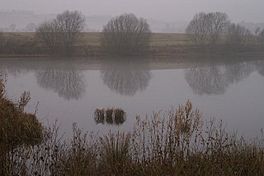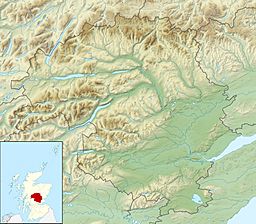White Loch, Perth and Kinross facts for kids
Quick facts for kids White Loch |
|
|---|---|

White Loch Living up to its name on a misty morning, 31 December 2007
|
|
| Coordinates | 56°34′15″N 3°21′09″W / 56.570700°N 3.352500°W |
| Type | freshwater loch |
| Max. length | 0.4828 km (0.3000 mi) |
| Max. width | 0.225 km (0.140 mi) |
| Surface area | 4.9 ha (12 acres) |
| Average depth | 13 ft (4.0 m) |
| Max. depth | 32 ft (9.8 m) |
| Water volume | 8,425,000 cu ft (238,600 m3) |
| Shore length1 | 1.2 km (0.75 mi) |
| Surface elevation | 48 m (157 ft) |
| Max. temperature | 59 °F (15 °C) |
| Min. temperature | 50.2 °F (10.1 °C) |
| Islands | 0 |
| 1 Shore length is not a well-defined measure. | |
White Loch is a small, freshwater lake, also known as a "loch" in Scotland. It's located in a low-lying area, just east of another lake called Fingask Loch. You can find it in the valley of the Lunan Burn, about 1.5 miles south of Blairgowrie, in the region of Perth and Kinross.
This special loch is important for nature. It has been given two important titles: a Site of Special Scientific Interest (SSSI) and part of a Special Area of Conservation. These titles mean the area is protected because of its unique wildlife and habitats.
Contents
About White Loch
White Loch is a freshwater loch, which means it's a lake filled with fresh water, not salty ocean water. It's considered a lowland loch because it's not high up in the mountains.
- The loch is about 0.48 kilometers (0.3 miles) long.
- It is around 0.22 kilometers (0.14 miles) wide.
- The deepest part of the loch is about 9.75 meters (32 feet).
- The shoreline, or the edge of the loch, stretches for about 1.2 kilometers (0.75 miles).
- It sits at an elevation of 48 meters (157 feet) above sea level.
Why White Loch is Special
White Loch is very important for its natural environment. It's recognized as a protected area for two main reasons:
Site of Special Scientific Interest (SSSI)
Being a Site of Special Scientific Interest (SSSI) means that White Loch has plants, animals, or geological features that are rare or very important to science. This protection helps to keep these special parts of nature safe.
Special Area of Conservation (SAC)
White Loch is also part of a Special Area of Conservation (SAC). This is an even bigger protection status given by the European Union. It helps to protect certain habitats and species that are important across Europe. For White Loch, this means it's a key place for certain types of birds and other wildlife.
Wildlife at the Loch
Because White Loch is a protected area, it's a great place for many different kinds of wildlife.
- Birds: Many birds use the loch for feeding, resting, and nesting. It's known as a good spot for birdwatching. You might see ducks, geese, and other water birds.
- Plants: The plants around and in the loch provide food and shelter for animals. The protected status helps these plant communities thrive.
- Other Animals: The loch's freshwater environment supports various fish, insects, and other small creatures that are part of the local ecosystem.


